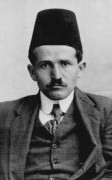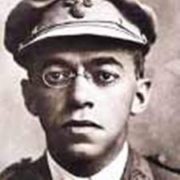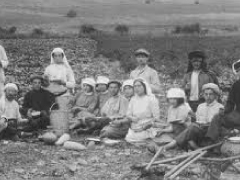In 1880, decades before Israel’s first prime minister, David Ben-Gurion, declared Israel to be a free and independent nation, Palestine was a backwater in the Ottoman Empire, populated by some 25,000 Jews and about 450,000 Arabs.

Two-thirds of the Jews in Palestine lived in Jerusalem and many of the rest resided in Safed, Tiberias and Hebron. They were a mixed lot. Half were Sephardic Jews whose ancestors had reached Palestine centuries ago. The remainder were Ashkenazic immigrants from eastern Europe who had begun arriving at the end of the 18th century. (There were, of course, a small number of Jews whose ancestors had never left Palestine).
Both groups were steeped in religion and tradition and immersed in the study of sacred Jewish texts. Since most of them were not gainfully employed, they were desperately poor and dependent on haluka, or charitable funds from abroad.

By 1890, the Jewish population of Palestine had doubled, fed by an influx of Russian Jews fleeing czarist pogroms. They, too, required financial assistance, which was provided by Baron Edmond de Rothschild, a British Zionist who poured money into nascent Jewish agricultural settlements. Although only a fraction of Jewish newcomers remained in Palestine, a forlorn, neglected and underdeveloped land, its Jewish population continued to rise. By 1914, 85,000 Jews lived in Palestine.
Within a little more than three decades, this small and marginal Jewish enclave was transformed into a vibrant state of around 600,000 Jewish inhabitants, served by a network of institutions, enlivened by a vigorous Hebrew culture and protected by an increasingly formidable army.
Israel’s development from dreamy concept to throbbing reality is the subject of The Origins of Israel: A Documentary History (The University of Wisconsin Press), a book of essays and letters previously unpublished or available only in Hebrew or other foreign languages.
The editors are Eran Kaplan of San Francisco State University and Derek Penslar of the University of Toronto and Oxford University.
These documents, accompanied by introductions and commentaries written by Kaplan and Penslar, convey the ferment, tensions, energy and anxiety that permeated the Yishuv, the Jewish communityof Palestine.
One of the prime topics they examine is Jewish settlements. Jewish settlers in rural colonies, plagued by disease and a lack of fresh water, infrastructure and experience in agriculture, turned to Rothschild for help. Rothschild basically funded nine settlements, including Rishon Le Zion, but his philanthropy was not always appreciated. In 1883, Jewish settlers staged a rebellion after complaining that his administrators had curtailed their freedom.
Rothschild warned the settlers he would “abandon” them if they did not shape up to his exacting standards. “Listen to me well and bear in mind,” he wrote. “I want to support workers, not beggars.” Clearly, as Kaplan and Penslar observe, there was a glaring disconnect between the idealism that animated the settlers and the harsh conditions they endured.
In 1889, Mordechai Ben Hillel Ha-Kohen, a journalist from Europe, visited the Rothschild settlements and wrote a series of newspaper stories. He concluded that while many of the farmers were “lazy” and shirked physical work, the baron’s “system” was flawed.
Conditions in Palestine were indeed hard, as letters from an anonymous farmer’s wife in 1889 and 1890 suggest. Although she complained about the heat and the prevalence of malaria, she was fundamentally content: “I never imagined a life that is better than the life we have today.”
Ben-Gurion, who settled in Palestine in 1906, visited Degania, the first kibbutz, in 1911 after reading reports that workers had gone on a strike. He wrote, “We now see a repetition of the old sins committed by imperious and malicious administrators who pay no heed to the demands and request of the inhabitants.”
Ben-Gurion’s report, the editors write, spoke to the tension between workers and the Zionist bureaucracy.
The revival of Hebrew is another topic they address, and in this spirit, they focus on Eliezer Ben Yehuda, the founder of the Plain Language Association and the man who was instrumental in reviving Hebrew in Palestine.
In an 1889 essay, he wrote, “The purpose of this association is to eradicate from the Jewish population in the Land of Israel the use of inferior vernacular dialects, which make us a laughing stock and an object of scorn in the eyes of our [Arab] neighbours …”
They also cite the work of Arthur Ruppin, the chief Zionist planner from 1908 to the mid-1920s. In a 1919 essay, he frankly spelled out the challenges that awaited new immigrants. Palestine, he acknowledged, is “unsuited for easy and comfortable living.” Only those who renounce “material pleasures and wordly amusements” can stay the course, he added. But in an upbeat forecast, he predicted that “life …will become more comfortable” once “better transportation” exists.
As well, Kaplan and Penslar focus on Yitzhak Gruenbaum, a Zionist leader from Poland who immigrated to Palestine in 1933. His exuberant impressions of Tel Aviv are striking: “New buildings and new streets are constantly added. The city changes its form and its character. It is in a state of flux. Everything is percolating, seething, bubbling. Everywhere you look, you see spurts of creativity, the joy of labor, expanding horizons, new opportunities and fresh beginnings.” He concluded: “Living in Tel Aviv has restored confidence in Jewish hearts.”
As might be expected, the Arab issue is a recurring one in The Origins of Israel.
The Zionist theoretician Ahad ha-Am (Asher Ginzberg) warned in a prescient essay in 1891 that Palestine was far from empty, as some of his colleagues falsely claimed. As he put it, “From abroad, we are accustomed to believing that the Arabs are all desert savages, like donkeys who neither see nor understand what is going on around them. But this is a big mistake.”
He warned that if the Yishuv “develops to the point of encroaching upon the native population, they will not easily yield their place.”
The perennial Arab question was taken up by the General Federation of Laborers in the Land of Israel in 1930. In a memorandum, the federation warned that even Arabs who benefit from the Zionist movement – owners of large estates and big merchants – are “hostile to Jewish colonization.”
As it should, the question of partition figures prominently in The Origins of Israel. Ben-Gurion, in a letter to his son in 1937, expressed opposition to partitioning Palestine, an idea advanced by the British authorities. “But … in the partition plan, we receive more than we own, though less, much less, than what we deserve and want,” he stated.
Then, in an astonishing burst of honesty, he wrote that while he would accept partition now, he hoped “to redeem the entire country … either through mutual agreement” with the Arabs “or through other means.”
Ben-Gurion, in a 1941 memorandum, left the impression of being a territorial maximalist, saying that “what we have in mind is at least the whole of western Palestine” (present-day Israel and the West Bank). At other times, he argued that a Jewish state should include the Negev and “the waters of the Jordan and the Litani” (in Lebanon).

Vladimir Jabotinsky, the icon of Revisionist Zionism, brought a strong dose of skepticism to a 1923 essay: “Voluntary reconciliation between the Palestinian Arabs and us is absolutely out of the question, whether now or in the foreseeable future.”
Categorically rejecting “the fantasy that they will voluntarily agree to the realization of Zionism in exchange for cultural or material conveniences,” he called for building an iron wall to fence off the Yishuv from Palestinian Arabs.
The more things change, the more they seem to remain the same. Or so it would seem.
